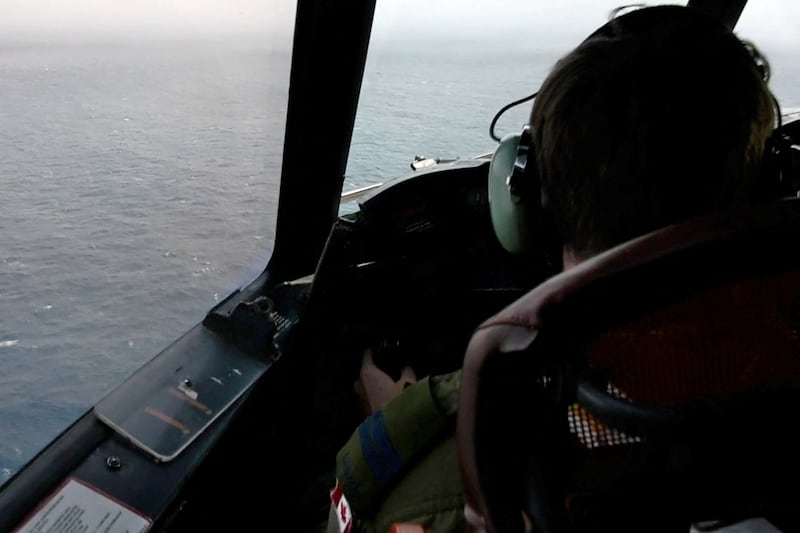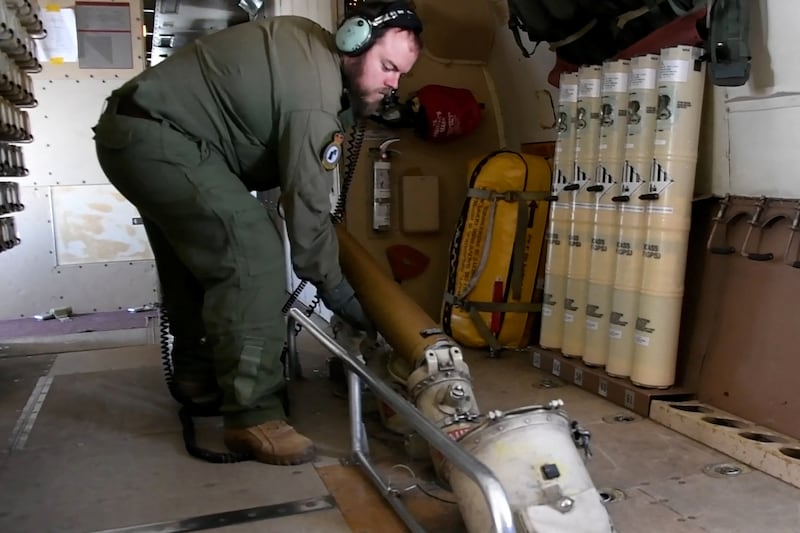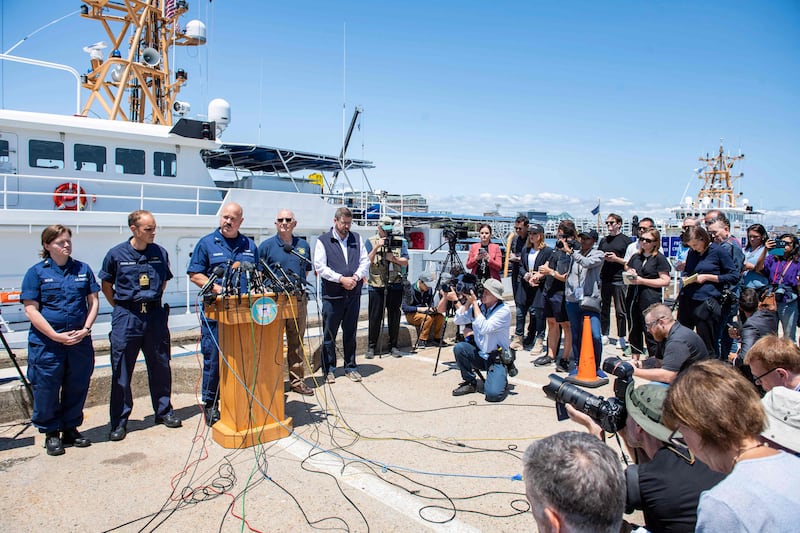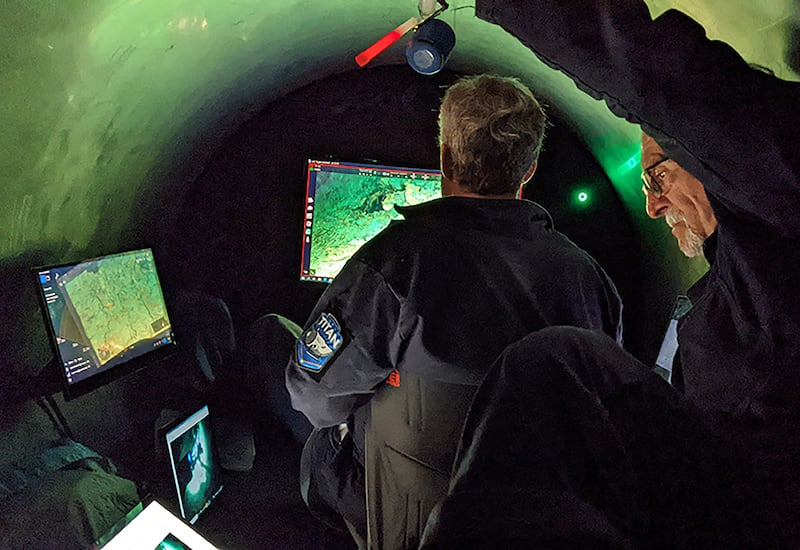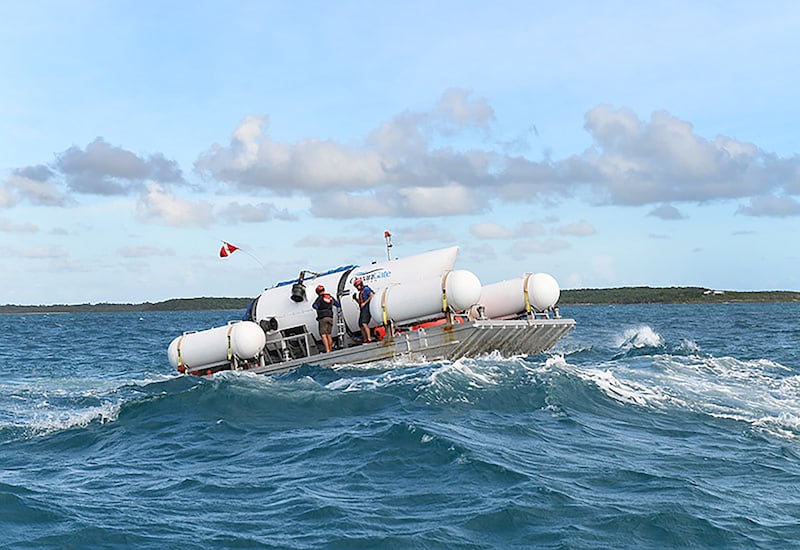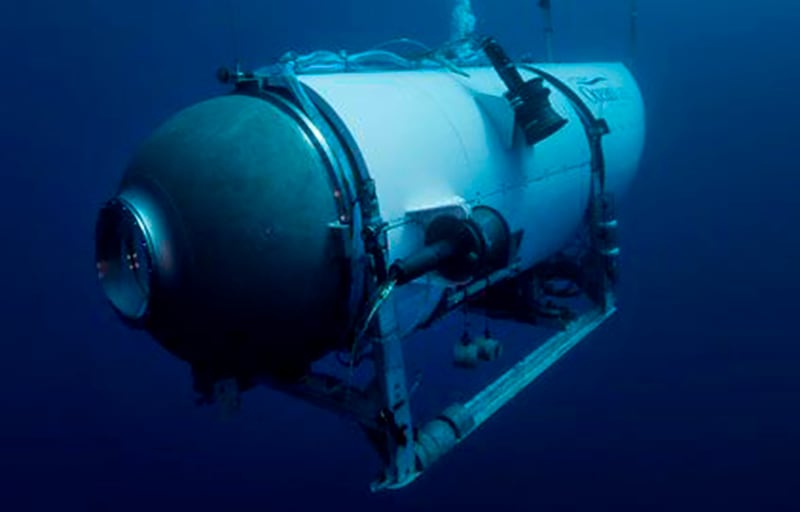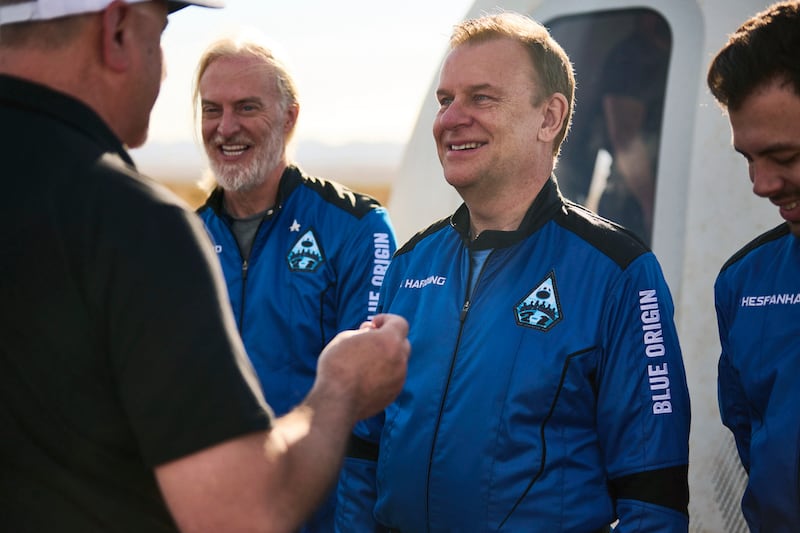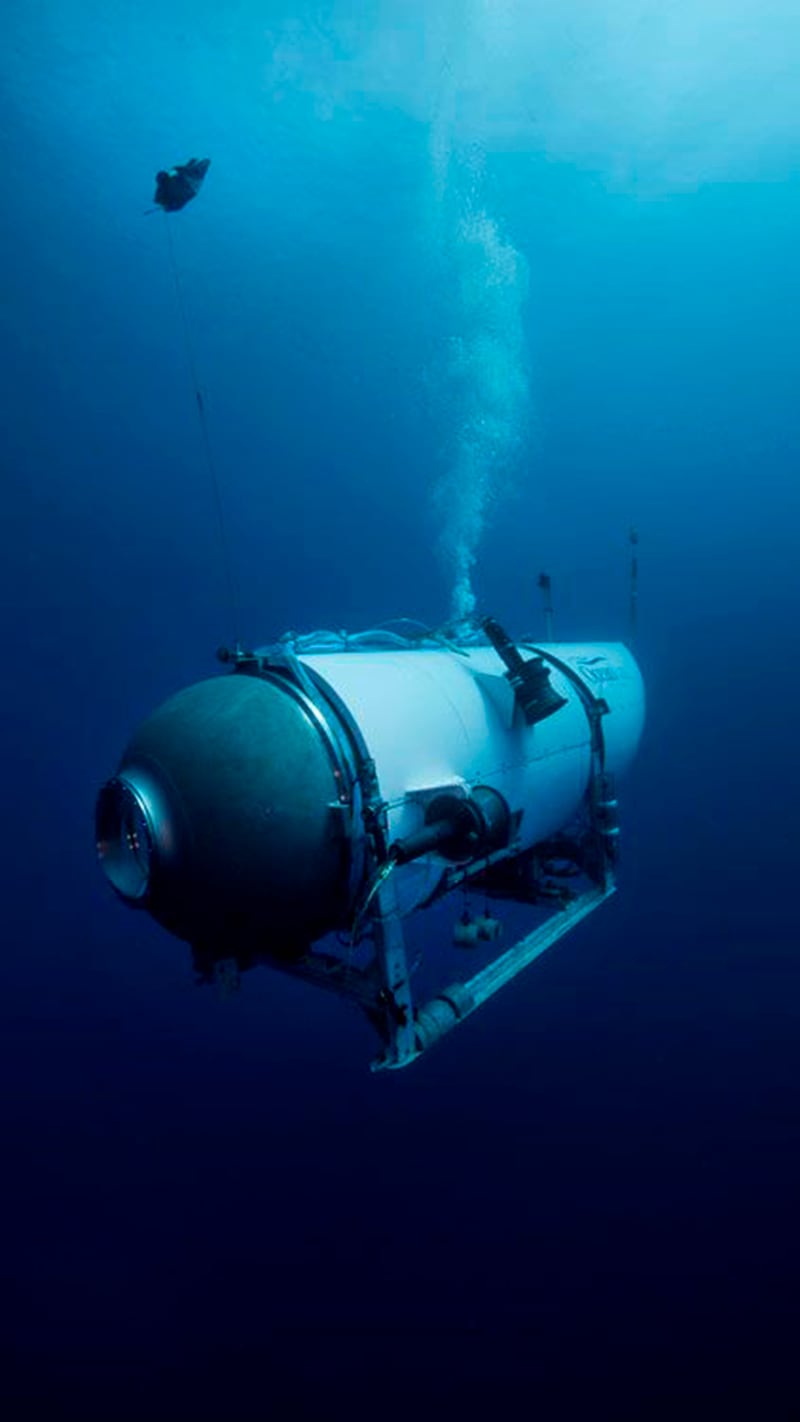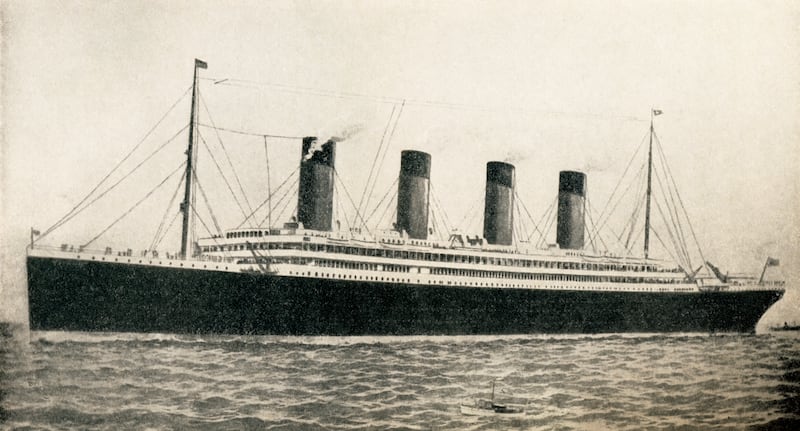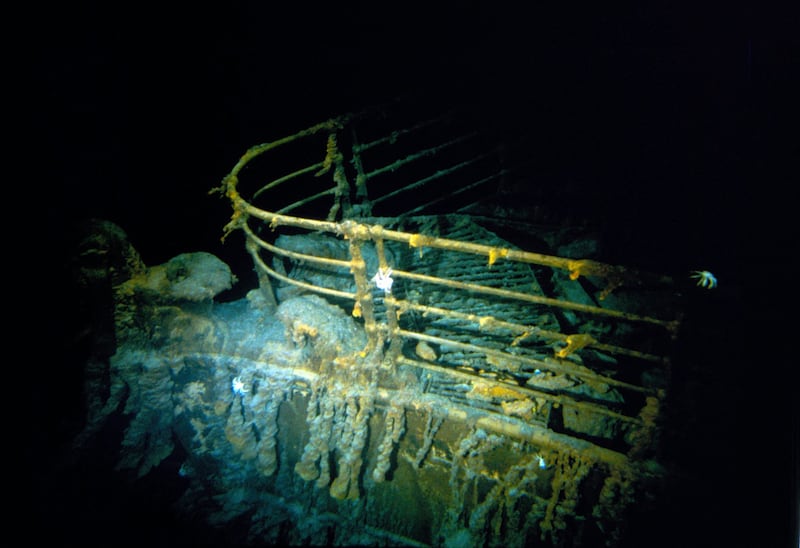Follow the latest news on the missing Titanic sub here
The search for Titan, a submersible on a mission to take tourists to see the century-old wreck of the Titanic near Newfoundland, has stretched into a fourth day after underwater noises were detected by rescuers.
The mother ship lost contact with the mini-sub on Sunday, prompting a massive search operation involving the US and Canadian coastguards.
The mini-sub was designed to remain underwater for 96 hours, giving its occupants until Thursday morning before air supply runs out, if the craft is still intact.
"Canadian P-3 aircraft detected underwater noises in the search area. As a result, ROV (remotely operated vehicle) operations were relocated in an attempt to explore the origin of the noises," the US Coast Guard's First District said on its official Twitter page.
The coastguard did not give details on the nature of the sounds, but CNN and Rolling Stone magazine, citing internal US government communications, independently reported late on Tuesday that “banging” sounds had been heard at 30-minute intervals.
Where was the Titan when it lost contact?
The submarine was taking people to see the wreck of the Titanic, which sits about 4,000 metres under the Atlantic Ocean, roughly 400 nautical miles from Newfoundland in Canada.
When it sank, the ship broke into two parts – the stern and the bow, which is the largest and most intact section, located at 41°43′57′′ N 49°56′49′′ W. The co-ordinates should theoretically make it easier for explorers to find.
But instruments do not always work well so deep under the water. Writer Mike Reiss, who travelled on Titan last year, spoke about the challenges of finding the wreck, on BBC Breakfast on Tuesday.
He said: “In my case, we got down and we were just I think 500 metres from the Titanic, but it is pitch dark down there. The radar or the compass stopped working.

“We spent most of our time down there just kind of flailing around, trying to find the biggest thing in the ocean and we couldn’t see it.
“And just to raise the tension, as if we needed that, a hurricane was coming in over the ocean, so we didn’t have a lot of time to explore. But with just 20 minutes left on the voyage we found the Titanic.
“And it was enough I have to say for a photo op. We got there and I got to take pictures of the anchor and the bow of the ship and the railing and that kind of thing.”
Where is the search taking place?
The Titan is believed to be positioned approximately 900 miles to the east and 400 miles to the south of Newfoundland.
The precise depth of the vessel remains uncertain, as the seabed lies approximately 3,800 meters below the water's surface.
How much oxygen supply does the Titan have?
The US Coast Guard projects the oxygen in the Titan submersible will likely run out sometime on Thursday morning.
The submersible has a 96-hour supply, which based on its Sunday launch time, would be completely depleted by 7:08am local time (3:08pm UAE time) on Thursday.
A Coast Guard spokesman said on Wednesday evening there was fewer than 20 hours' supply remaining.
What could have happened to it?
Alistair Greig, a professor of marine engineering at University College London, said submersibles typically have a drop weight, which is “a mass they can release in the case of an emergency to bring them up to the surface using buoyancy.”
“If there was a power failure and/or communication failure, this might have happened, and the submersible would then be bobbing about on the surface waiting to be found,” Mr Greig said.
Colonel Terry Virts, a former US pilot and friend of Mr Harding, said the reports of banging was the news he had been hoping for.
He told Radio 4's Today show on Wednesday: "That's the news I've been looking forward to all day long and that is during the search they've heard some banging on the walls of the submersible.
"That's the best way to communicate with us and that's the news we've been hoping to hear."
He described Mr Harding as the "quintessential" British explorer adding that the design of the vessel is very simple, meaning there are not many things that can break on it.
"I was talking to someone who was on the sub last year and really the only emergency you can handle is a fire. Everything else you go to the surface and the sub has a bunch of ways to get to the surface. You can drop a bunch of weights and that should make it go up. There’s apparently some type of balloon system. I’m not exactly sure," he said.
But none of those systems worked, meaning it is "probably stuck on something", Colonel Virts added.
"To me it sounds like, and I don’t have any insider information, it sounds like it is just sitting there stuck underneath Titanic somehow.
"And by the way other submarines on other missions past have gotten stuck under their propeller and behind walls. Apparently that’s a dangerous place to operate because you just have one window.
"It’s not like when you are backing up your car you have your backup camera, you have your two mirrors and your rear mirror. I hope that’s the problem. That would be the best case scenario because it would mean they are still alive and there would be at least a hope for rescue."
Who is on board?
Pakistani businessman Shahzada Dawood and his son Suleman are two of the passengers on board the craft. The Dawood family runs one of Pakistan’s biggest business conglomerates, with investments in agriculture, industries and the health sector. Mr Dawood is also an adviser of Prince's Trust International. On Tuesday, the chief executive of the charity said it is shocked by the news.
Will Straw said: "Prince's Trust International has a longstanding relationship with Shahzada Dawood and his family.
"We are shocked by this awful news, praying for a rescue and sending our thoughts to his family during this deeply challenging time".
Suleman Dawood is a student at Strathclyde University in Glasgow. A statement from the family highlighted Suleman's enthusiasm for science fiction literature, his passion for learning new things, and his interest in activities such as solving Rubik's Cube puzzles and playing volleyball.
A fourth confirmed passenger is Hamish Harding, a British billionaire who lives in the UAE and flew into space last year. On Tuesday, Private plane firm Action Aviation said the family of its missing chairman Mr Harding are "very grateful" for the "kind messages" over the disappearance off the coast of Canada of the submersible tourist vessel he is on.

A French navy pilot, Paul-Henry Nargeolet, and the boss of tour company OceanGate, Stockton Rush, is also on the voyage.
Who is involved in the search and what equipment is being used?
The search operation involves multiple entities and a variety of equipment.
Among the vessels involved in the rescue are Polar Prince, Deep Energy, Atlantic Merlin, Skandi Vinland and Horizon Arctic. They are joined by Canadian Coast Guard vessels CCGS John Cabot, CCGS Ann Harvey and CCGS Terry Fox; Royal Canadian Navy vessel HMCS Glace Bay (equipped with a mobile decompression chamber and medical personnel); and French research vessel L'Atalante.
L'Atalante is equipped with the Victor 6000 robot, which can assist in cutting cables and conducting manoeuvres to release a stranded vessel. However, it is incapable of lifting objects independently.
The Horizon Arctic is believed to have a Flyaway Deep Ocean Salvage System (FADOSS) on board. This system includes a winch and a long cable suitable for pulling objects to the surface.
Potential rescue options for the submersible involve either winching it up from the seafloor, which presents substantial challenges due to the extreme depth, or using a flotation device or lift bag to raise the vessel.
Both methods would require the use of remotely operated vehicles and face potential obstacles if the sub is entangled in debris.
The situation is unprecedented and would require ROV operators to adapt their tactics to the unique challenges.
How challenging is the search?
Chris Parry, a former rear admiral in Britain’s Royal Navy, said the small vehicle could be difficult to find if it was deep in an ocean canyon among the debris of the Titanic itself.
He said that even if the passengers were found alive, it would be impossible to transfer them into another vehicle at that depth. Rescuers would have to try to lift the Titan out with a crane and a long wire, or send another submersible with “grabbing arms” to bring it to the surface, he told Sky News.
“I’m normally optimistic, but I have to tell you in these circumstances it’s very worrying indeed,” he said.

How deep does the Titan dive and who owns it?
The Titan vessel carrying the five is a submersible, which requires a mother ship from which to launch, to return to, and for support and communications.
It is designed to reach depths of 4,000 meters (13,123 feet), where the Titanic rested.
According to its owner OceanGate, which is based in Everett in Washington State in the US, it is the only manned submersible to use a “real-time health monitoring system” which monitors the effects of the pressure on the structure during dives. It is designed to provide an early warning system to alert the operator to any problems.
“This on-board health analysis monitoring system provides early warning detection for the pilot with enough time to arrest the descent and safely return to surface,” says the company's website.
The company says the vessel is lighter in weight and therefore more cost efficient to mobilise than any other deep diving submersible.
But it is surprisingly simple inside. Mr Reiss said: “You have to picture a van, an SUV with the seats taken out. It’s about that size. It seats five passengers comfortably but you are just sitting on the floor.
“When you get to the bottom, the ship is propelled by very tiny motors that look like a fan you would have on your desk. And it is steered literally by an X-Box joystick from a game system.
“You are very taken with how simple it is.”
OceanGate has successfully completed more than 14 expeditions and more than 200 dives in the Pacific, Atlantic and Gulf of Mexico, according to the company’s website.
“Following every mission, the team evaluates and updates the procedures as part of a continued commitment to evolve and ensure operational safety,” it states.

Why did they go down there?
The tourists had each paid $250,000 to see the 1912 wreck. According to an entry in Britannica, the ill-fated liner captured the imagination of the public from the outset.
Initially considered unsinkable, it hit an iceberg and went down off Newfoundland four days into its maiden voyage.
The wreckage was discovered in 1985, reigniting interest in the ship, which was the subject of a Hollywood movie of the same name in 1997.
